If you’ve ever wondered about the magic of transforming a tiny seed into a crunchy, delicious carrot, you’re in the right place. This article is your comprehensive guide to becoming a true carrot whisperer.
Quick tips for growing carrots from seed: Start by choosing the right soil, ideally a light sandy loam with a pH between 6 and 7. Select a carrot variety that suits your soil and taste preferences, such as Imperator, Danvers, Nantes, or Chantenay. Plant in spring or fall, depending on your climate. Sow seeds directly in the garden, about 1/4 to 1/2 inch deep, and keep the soil consistently moist. Carrots need full sun, at least six to eight hours per day. Thin seedlings to a distance of 2 inches apart when they’re about 1 to 2 inches tall. Implement succession planting for a continuous harvest and monitor for pests and diseases. Harvest when carrots reach a usable size.
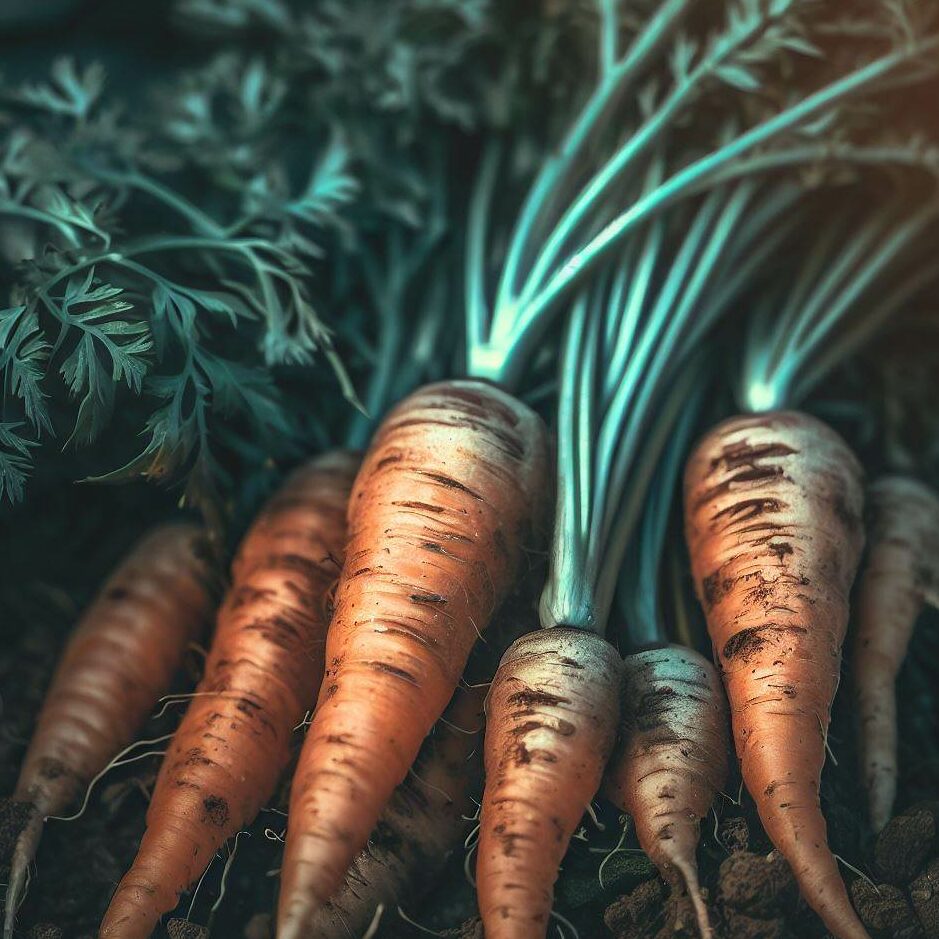
Growing Carrots from Seed
Why grow carrots from seed? There’s something incredibly satisfying about nurturing a plant from its earliest stages and watching it grow under your care. Plus, growing carrots from seed offers a range of benefits:
- It’s cost-effective: A packet of seeds can produce a bountiful harvest for a fraction of the cost of store-bought carrots.
- It’s environmentally friendly: By growing your own carrots, you’re reducing the need for commercially grown produce, which often involves heavy pesticide use and long-distance transportation.
- It’s a great learning experience: Understanding the life cycle of a plant is a wonderful educational opportunity for both kids and adults.
🥕 Carrot Clues: Growing your own carrots also allows you to explore a variety of types that you might not find in your local grocery store. Ever tried a purple carrot? Now’s your chance! 🥕
From selecting the right soil and carrot variety to understanding the perfect planting time, we’ll cover all the essential steps. We’ll also delve into the specific tips for growing carrots from seed, watering, thinning seedlings, and finally, the joy of harvesting.
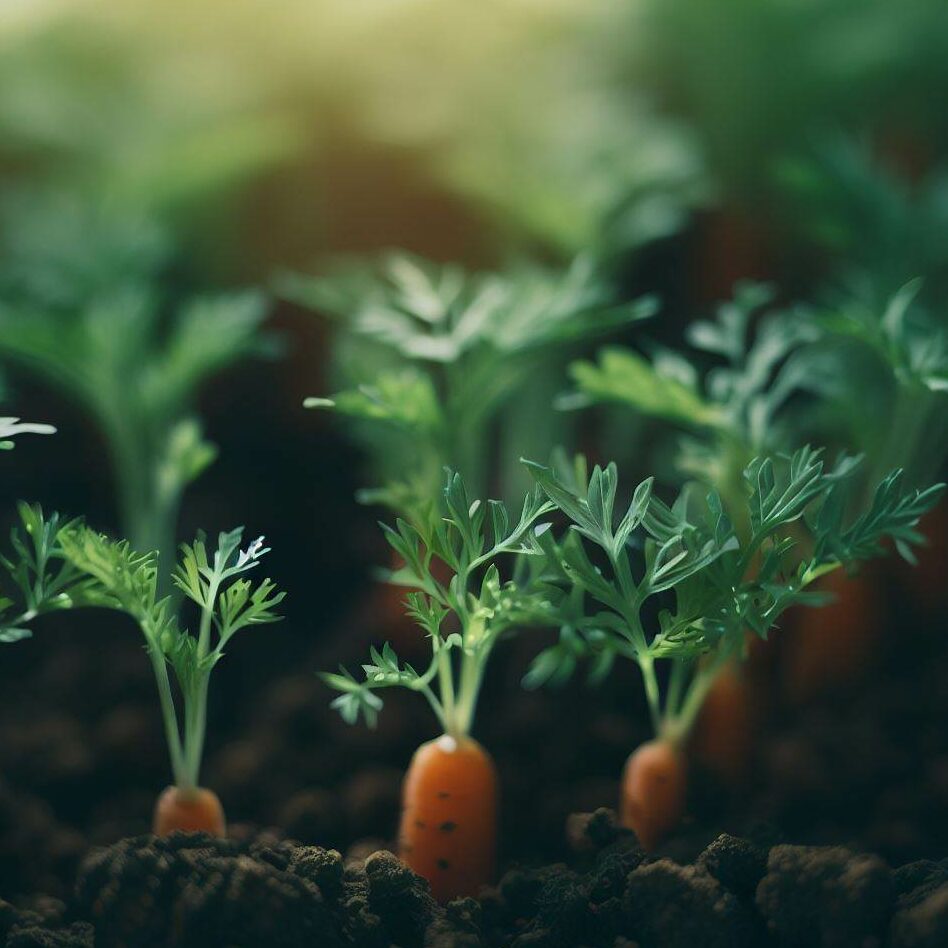
Choosing the Right Soil for Carrots
So, you’re ready to plant your carrot seeds. But before you start, it’s crucial to understand the importance of soil. The right soil can make the difference between a bountiful harvest and a disappointing yield.
Carrots prefer a light, sandy loam soil with a neutral to slightly acidic pH between 6 and 7. This type of soil is loose and well-drained, allowing the carrot roots to grow long and straight. If your soil is heavy clay or silt, don’t worry! You can still grow great carrots with a bit of preparation.
- First, consider growing your carrots in raised beds. Raised beds allow you to control the soil quality and drainage, providing an ideal environment for your carrots.
- Second, improve your soil by adding organic matter and well-decomposed compost. This will help to lighten the soil texture and provide essential nutrients for your carrots.
🥕 Carrot Clues: Avoid using fresh manure or high-nitrogen fertilizers. They can cause carrots to fork or become hairy. 🥕
Putting in a little effort in preparing your soil can go a long way in ensuring a successful carrot harvest.
Selecting the Right Carrot Variety
Now that your soil is ready, it’s time to choose your carrot variety. But with so many options, how do you decide? Let’s take a look at the main categories of carrots to help you make an informed choice.
- Imperator: These are the long, slender carrots you often see in grocery stores. They need deep, well-drained soil.
- Danvers: These carrots are shorter and thicker than Imperators, making them a good choice for heavier soils.
- Nantes: Known for their sweet flavor, Nantes carrots are medium-sized and do well in a variety of soil types.
- Chantenay: These carrots are short and broad, making them ideal for shallow or rocky soils.
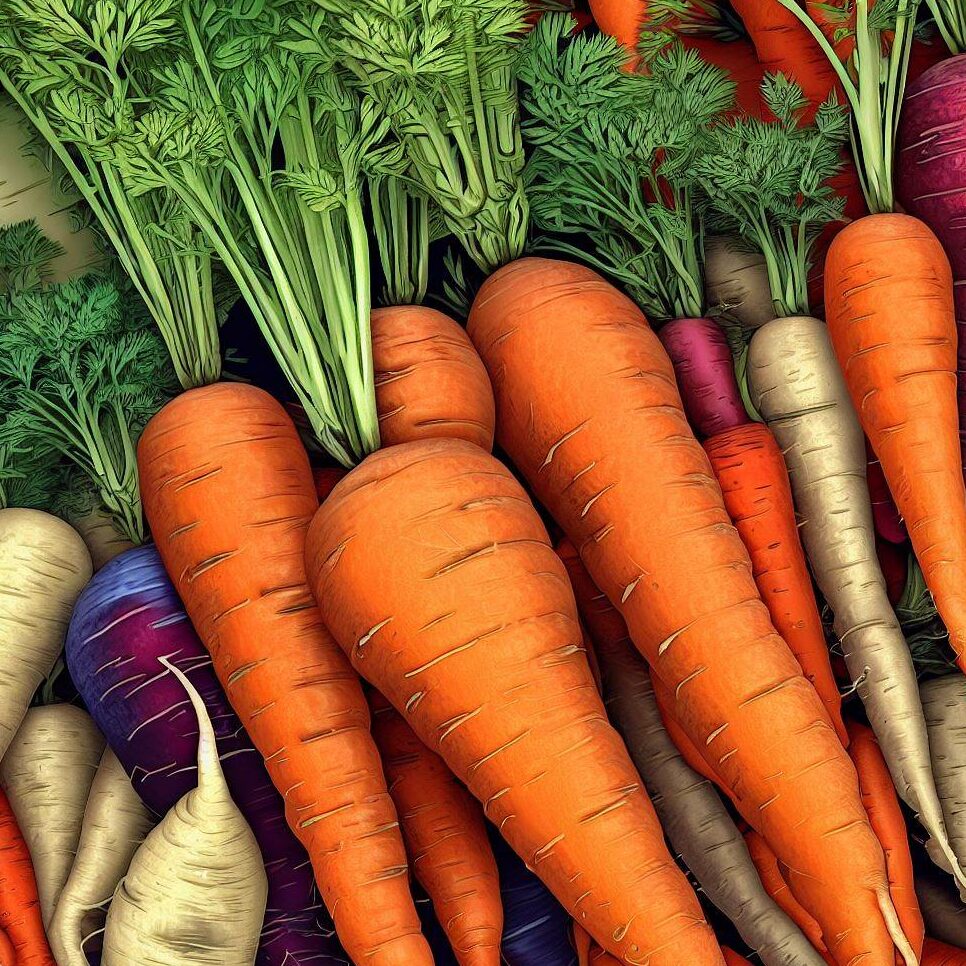
When choosing a carrot variety, consider your soil type and your personal preferences for taste, size, and color. Do you want a classic orange carrot, or are you interested in trying a purple or yellow variety? Do you prefer a sweet or earthy flavor? These are all things to consider.
🥕 Carrot Clues: Try planting a few different varieties to see which ones you like best. Gardening is all about experimentation! 🥕
Remember, the best carrot variety is the one that brings you joy to grow and eat.
Planting Time for Carrots
With your soil prepared and your carrot variety chosen, you might be eager to start planting. But hold on! Timing is everything when it comes to growing carrots. Let’s explore the best time to plant your carrot seeds.
Carrots are a cool-season crop, which means they grow best in cooler temperatures. In most regions, you can plant carrots as soon as the soil is workable in spring, even two to three weeks before the last frost. The cool spring weather helps the seeds germinate and the plants grow strong before the heat of summer.
In warmer climates, you might have better luck growing carrots in the fall and through the winter. The mild winter temperatures can result in sweet, tender carrots.
🥕 Carrot Clues: If you’re not sure when to plant carrots in your area, check with your local extension service or garden center. They can provide valuable advice based on your local climate and conditions. 🥕
Remember, patience is key in gardening. By waiting for the right planting time, you’re setting your carrots up for a successful growing season. So, mark your calendar and get ready to plant!
Sowing Carrot Seeds in the Garden
Now that we’ve covered the groundwork (pun intended), it’s time to get your hands dirty and start sowing those carrot seeds. But how exactly do you go about it? Let’s break it down step by step.
Tips for growing carrots from seed:
- Prepare the soil: Make sure your soil is well-prepared as we discussed earlier. Remove any rocks or debris that could obstruct the growth of your carrots.
- Make rows: Using a stick or your finger, make shallow rows about 1/4 to 1/2 inch deep in the soil.
- Sow the seeds: Sprinkle the carrot seeds along the rows. Try to space them about 1 to 2 inches apart, but don’t worry if they’re not perfect. You’ll thin them out later.
- Cover the seeds: Gently cover the seeds with soil. Don’t pack it down too hard; you want the soil to be loose enough for the seedlings to push through.
- Water gently: Using a watering can or a hose with a gentle spray, water the area. Keep the soil consistently moist until the seeds germinate.
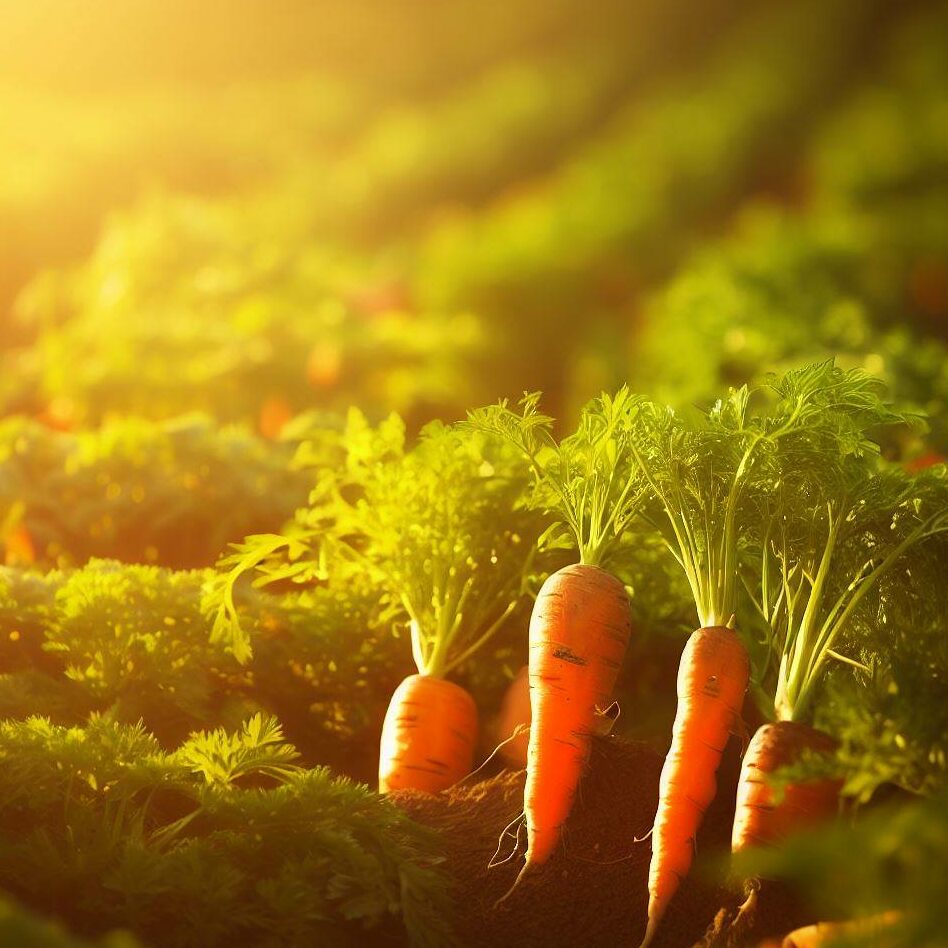
Do I soak carrot seeds before planting?
While some gardeners swear by this method, it’s not necessary. Carrot seeds can germinate without pre-soaking, and soaking can lead to a risk of the seeds rotting if they’re not planted immediately after soaking.
🥕 Carrot Clues: Carrot seeds are tiny and can be difficult to handle. Consider mixing them with some sand before sowing to help spread them out more evenly. 🥕
Remember, carrots should be planted directly in the garden, as transplanting them from pots can cause damage to the delicate taproot. With these steps, you’re well on your way to growing your own delicious carrots from seed!
Watering and Sunlight Requirements for Carrots
Just like us, carrots need a good balance of water and sunlight to thrive. But how much is just right? Let’s dive into the watering and sunlight requirements for growing healthy, delicious carrots.
When it comes to watering, consistency is key. Carrots need a steady supply of water to grow well. The soil should be kept consistently moist, but not waterlogged. Overwatering can lead to problems like root rot, while underwatering can result in stunted growth.
🥕 Carrot Clues: A good rule of thumb is to water your carrots about 1 inch of water per week, including rainfall. Adjust as necessary based on your local weather conditions and soil type. 🥕
It’s best to water deeply and thoroughly, allowing the soil to dry slightly before watering again. This encourages the carrot roots to grow deep into the soil in search of moisture. Shallow irrigation, on the other hand, can lead to short, shallow carrots.
Sunlight Requirements
As for sunlight, carrots prefer full sun, but they can tolerate a little shade, especially in the late afternoon. Ensure your carrots receive at least six to eight hours of sunlight per day. If you’re growing carrots in a part of your garden that doesn’t get quite that much sun, don’t worry. They’ll still grow, but they might take a little longer to reach their full size.
Remember, every garden is unique. Pay attention to your carrots and adjust your watering and sunlight practices as needed. With the right care, your carrots will be ready to harvest before you know it!
Thinning Carrot Seedlings
Once your carrot seeds have sprouted and the seedlings are about 1 to 2 inches tall, it’s time for a crucial step in the carrot-growing process: thinning. But what is thinning, and why is it necessary? Let’s find out.
Thinning is the process of removing some plants to make room for others to grow. Carrot seedlings need to be thinned to a distance of about 2 inches apart. This gives each carrot enough space to grow to its full size. Without thinning, your carrots will be crowded and may not grow properly.
Here’s how to thin your carrot seedlings:
- Choose the strongest seedlings: Look for the seedlings that are tallest and have the most leaves. These are the strongest and most likely to survive.
- Snip, don’t pull: Use a pair of scissors to snip the unwanted seedlings at soil level. Pulling them out can disturb the roots of the remaining carrots.
- Water after thinning: Water your carrots after thinning to help the remaining plants recover from any disturbance.
🥕 Carrot Clues: If you’re having trouble deciding which seedlings to remove, remember that it’s better to leave a gap than to leave two carrots too close together. A gap will just mean one less carrot, but two carrots too close together will compete for resources and may not grow well. 🥕
Thinning might seem like a waste, but it’s an essential step for growing big, healthy carrots.
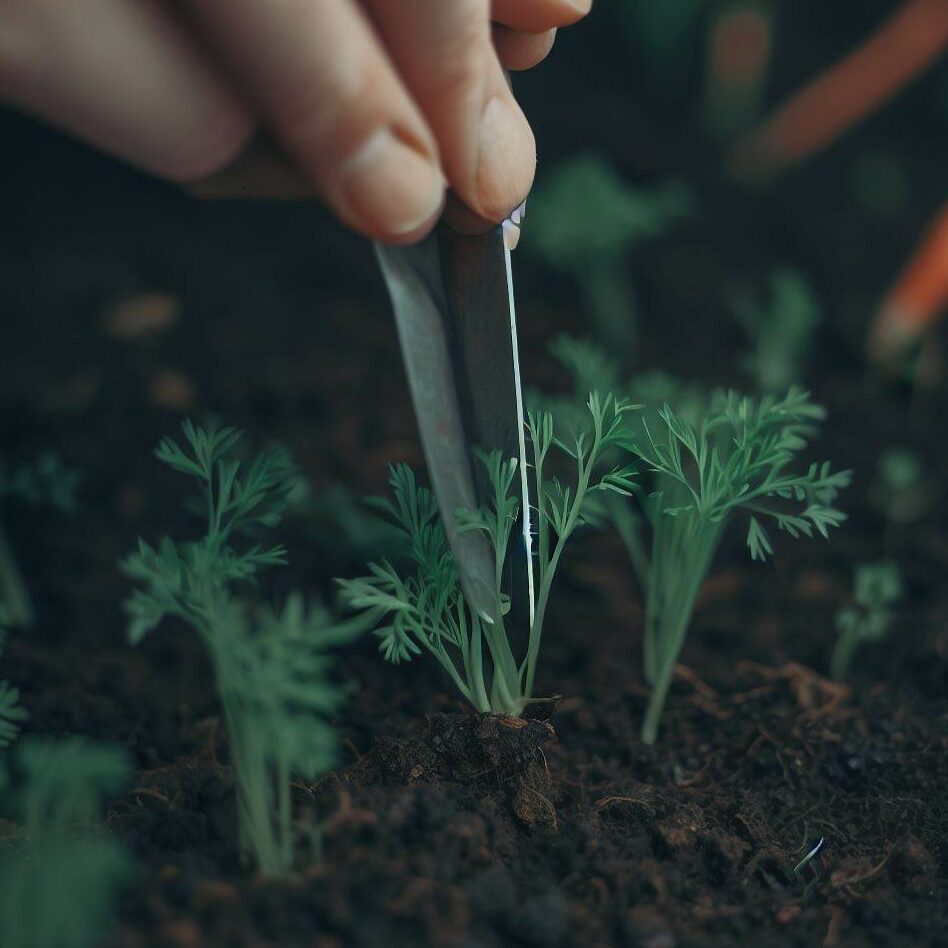
Succession Planting for Continuous Harvest
Imagine having a continuous supply of fresh, homegrown carrots throughout the growing season. Sounds wonderful, doesn’t it? This dream can become a reality with a technique called succession planting. Let’s explore how you can implement this in your garden.
Succession planting is the practice of sowing seeds at intervals to ensure a continuous harvest. Instead of planting all your carrot seeds at once, you plant a new batch every 2 to 3 weeks. This way, as you harvest one batch of carrots, the next batch is already growing and will be ready to harvest in a few weeks.
Here’s how to do it:
- Plan your schedule: Decide how often you want to plant new carrot seeds. Every 2 to 3 weeks is a good starting point.
- Prepare the soil: Each time you’re ready to plant a new batch of seeds, prepare the soil just as you did for the first batch.
- Plant the seeds: Sow your carrot seeds following the same steps as before.
🥕 Carrot Clues: Keep an eye on the weather. If a hot spell is coming up, you might want to wait until it’s over before planting your next batch of seeds. Carrots are a cool-season crop and can struggle in hot weather. 🥕
With succession planting, you can enjoy the fruits (or in this case, roots) of your labor all season long.
Pest and Disease Control for Carrots
While growing carrots can be a rewarding experience, it’s not without its challenges. Pests and diseases can pose a threat to your carrot crop. But don’t worry, with some knowledge and preventative measures, you can keep your carrots healthy and thriving.
Common pests that affect carrots include carrot flies, wireworms, and aphids. Diseases that can affect carrots include leaf blight, root knot nematodes, and carrot rust flies.
🥕 Carrot Clues: If you notice pests or disease, identify the problem before treating. Different problems require different solutions, and using the wrong treatment can be ineffective or even harmful to your plants. 🥕
Here are some tips for prevention and control:
- Rotate your crops: Don’t plant carrots in the same spot every year. Crop rotation can help prevent the buildup of pests and diseases.
- Keep your garden clean: Remove plant debris and weeds, which can harbor pests and diseases.
- Use row covers: Row covers can help protect your carrots from pests like carrot flies.
- Monitor your garden: Regularly check your plants for signs of pests or disease. Early detection can make treatment more effective.
Harvesting Carrots
After all your hard work and patience, the time has finally come to reap the fruits (or in this case, roots) of your labor. Harvesting carrots is a simple process, but there are a few tips and tricks to ensure you get the most out of your crop.
Carrots can be harvested any time they reach a usable size. However, for most varieties, they are usually ready to harvest 70 to 80 days after planting. To harvest, simply grasp the carrot tops and pull. If the soil is hard, use a garden fork to loosen it.
Here are some tips to improve your carrot harvest and flavor:
- Harvest in the morning: Carrots harvested in the cool of the morning tend to be crisper and more flavorful.
- Leave some carrots in the ground: If you live in an area with mild winters, you can leave some carrots in the ground to harvest in early spring. The cold can actually make them sweeter!
- Store properly: Cut off the tops, wash the carrots, and store them in a cool, humid place. They can last several months if stored properly.
🥕 Carrot Clues: Did you know that the flavor of carrots improves after a light frost? So, you may want to wait until late fall or even early spring to harvest some varieties. 🥕
This video from Daisy Creek Farms provides a guide on growing carrots from seed to harvest. They emphasize loose soil, demonstrate planting techniques, and highlight the slow germination process. They show the progress of carrot plants over time, emphasize the need for regular watering, and conclude with a satisfying carrot harvest.
Frequently Asked Questions
Whenever I share my tips for growing carrots from seed with other gardeners, these are the questions that come up most often.
What is the trick to planting carrots?
The trick to planting carrots is to prepare a deep, loose, and well-drained soil. Sow the seeds directly in the garden, about 1/4 to 1/2 inch deep, and keep the soil consistently moist until germination.
How long does it take for carrots to start growing from seed?
Carrot seeds can take anywhere from 6 to 21 days to germinate, depending on the soil temperature and moisture levels. Once germinated, the plants will continue to grow and can be harvested in about 70 to 80 days.
Do I soak carrot seeds before planting?
Soaking carrot seeds before planting can speed up germination, but it’s not necessary. If you choose to soak your seeds, do so for only about 15 minutes to an hour. Any longer can cause the seeds to become waterlogged and decrease germination rates.
Should you water carrot seeds after planting?
Yes, it’s important to water carrot seeds after planting. Keep the soil consistently moist but not waterlogged. A light misting or gentle watering can help keep the soil moist without washing away the seeds.
Can I just scatter carrot seeds?
While you can scatter carrot seeds, it’s better to plant them in rows. This makes it easier to thin the seedlings and allows for better air circulation, which can help prevent disease.
Should you cover carrot seeds with cardboard?
Covering carrot seeds with a thin layer of compost or vermiculite is recommended to help keep them moist during germination. Some gardeners use cardboard or burlap to help retain moisture, but be sure to remove it as soon as the seeds start to germinate.
Should I water my carrot seeds every day?
It’s important to keep the soil consistently moist but not waterlogged. Depending on your climate and soil type, this may mean watering every day or every few days.
Should I put straw over carrot seeds?
Putting a light layer of straw over carrot seeds can help retain moisture and prevent the soil from crusting over, which can make it harder for the seedlings to break through. However, be sure to remove or thin the straw as the seedlings start to emerge.
Does Saran Wrap help seeds germinate?
Saran Wrap or any plastic wrap can create a mini greenhouse effect, helping to retain moisture and warmth, which can speed up germination. However, be sure to remove it as soon as the seeds start to germinate to prevent mold growth and to allow the seedlings to grow.
How many carrot seeds do you plant in one spot?
It’s best to plant two to three carrot seeds per spot. Once the seedlings are about an inch tall, thin them out so that there’s only one plant per spot.
How many carrots do you get out of one seed?
Each carrot seed will produce one carrot. However, by planting multiple seeds per spot and then thinning to the strongest seedling, you can ensure a better chance of success.
How far apart do carrot seeds need to be?
Carrot seeds should be sown about 1 to 2 inches apart. Once the seedlings are about an inch tall, thin them to about 2 to 3 inches apart to allow enough room for the carrots to grow.
Conclusion
From choosing the right soil and carrot variety to understanding the importance of watering, sunlight, and thinning, we’ve covered all the essential steps to successfully grow carrots from seed. We’ve also answered some of the most frequently asked questions about growing carrots.
Remember, every garden and every gardener is unique. Don’t be disheartened if your first attempt doesn’t yield perfect results. Gardening is a journey of learning and discovery. With patience, practice, and the tips provided in this guide, you’ll be well on your way to becoming a carrot whisperer. So, why wait? Start your carrot-growing journey today and reap the rewards of homegrown, delicious carrots.
